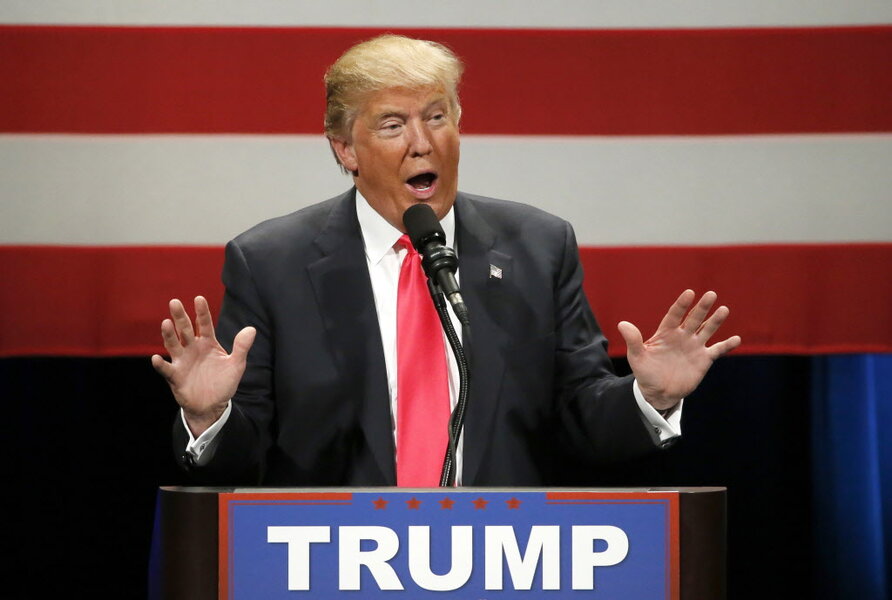The case of the hidden import tax
Loading...
My 11-year-old daughter and I were shopping for sneakers recently, and we wanted to stick to a budget. We found a pair she liked, and we liked the price, too. When I reminded her to add in Michigan’s 6 percent sales tax, she suggested, “They should tell you the sales tax on the price tag. The tax shouldn’t surprise you when you pay, because you might not have enough money.”
I reminded her that the sales tax isn’t really a surprise—she just forgot. But there’s another kind of tax whose impact might surprise a lot of us, especially when shopping for shoes: Tariffs that are imposed on imported goods.
GOP presidential hopeful Donald Trump says he might levy a 45 percent tax on all imports from China and 35 percent on many goods from Mexico. Democratic hopeful Bernie Sanders would undo the North American Free Trade Agreement, which eliminated virtually all tariffs on goods traded among the US, Mexico, and Canada. Trump and Sanders also oppose the pending Trans-Pacific Partnership Trade Deal, or TPP, which would eliminate or reduce tariffs on imports and exports of a variety of goods, including sneakers.
No doubt, the candidates speak to voters’ worries. A Pew Research Center survey conducted last spring found that only 43 percent of all Americans thought free trade was helpful to their personal finances. Only 38 percent of those earning less than $30,000 in a year believed international commerce helps them.
They are wary of the global economy where overseas factories produce goods more cheaply, and domestic manufacturing jobs are harder to find. That makes nervous workers easy targets for politicians who claim that tariffs—which raise the price of imported foreign goods—could increase the demand for products “Made in America” and inspire factories to return home and create more US jobs.
But it doesn’t quite work that way. As Carnegie Mellon University’s Brian Kovak told the Pittsburgh Post-Gazette after a Sanders rally last week, US manufacturing jobs have been declining for decades even as US factory production has been growing. “That suggests that automation was a primary driver of declining manufacturing employment,” he said. Not trade.
As a result, even if manufacturers reopened US plants in response to higher tariffs, they’d be highly automated and create relatively few jobs, especially for low-skilled workers. But those same import taxes would significantly boost prices, especially for inexpensive household goods that mostly benefit low-and moderate-income households.
Take those sneakers. Edward Gresser of the GlobalWorks Foundation’s Progressive Economy project shows current tariffs already raise the price of a pair of inexpensive sneakers by more than one-third, from $15.09 to $23.46.
Why wouldn’t consumers just buy domestic-made products to avoid the tariffs? They could, but in the absence of low-priced foreign competition, those US manufacturers would likely raise their own prices.
I could try to avoid the tariff by trying to find sneakers manufactured in the United States. But only a handful of shoe manufacturers remain in the US, few make athletic shoes, and those that do already charge closer to $100 a pair. While the latest Bloomberg poll shows 82 percent of Americans are willing to pay “a little more” for goods produced in the US, $100 is pretty steep for most families.
Chances are, a parent would still buy imported sneakers, but have to pay the higher price. Gresser estimates that families already spend $40 billion a year on tariffs on household goods, and figures the average single-parent household's share is $400 annually. That’s a lot of money, and as my TPC colleague Elaine Maag suggests, tariff policies run counter to the income-supporting goals of programs like the Earned Income Tax Credit or Child Tax Credit.
And there is more bad news. Foreign governments would certainly retaliate against those new US tariffs, imposing their own new taxes on US-made products sold in their countries. The result: American workers who produce exports would lose their jobs. Moody’s Analytics projects that Trump’s proposed new tariffs would kick off a trade war that would halt economic growth and cost America jobs.
Maybe candidates who propose higher tariffs should be more specific. How much more do they think American consumers should pay for imported goods? And how long do they expect consumers to wait for manufacturers’ return to the US? My daughter has the right idea: Put the cost of these new import taxes on the price tag.
I’m guessing a lot of consumers—and voters—would appreciate the information. My daughter would. She’s a kid, and her feet are still growing.
This article first appeared in TaxVox. The Tax Hound, publishing the first Wednesday of every month, helps make sense of tax policy for those outside the tax world and connects tax issues to everyday concerns.







